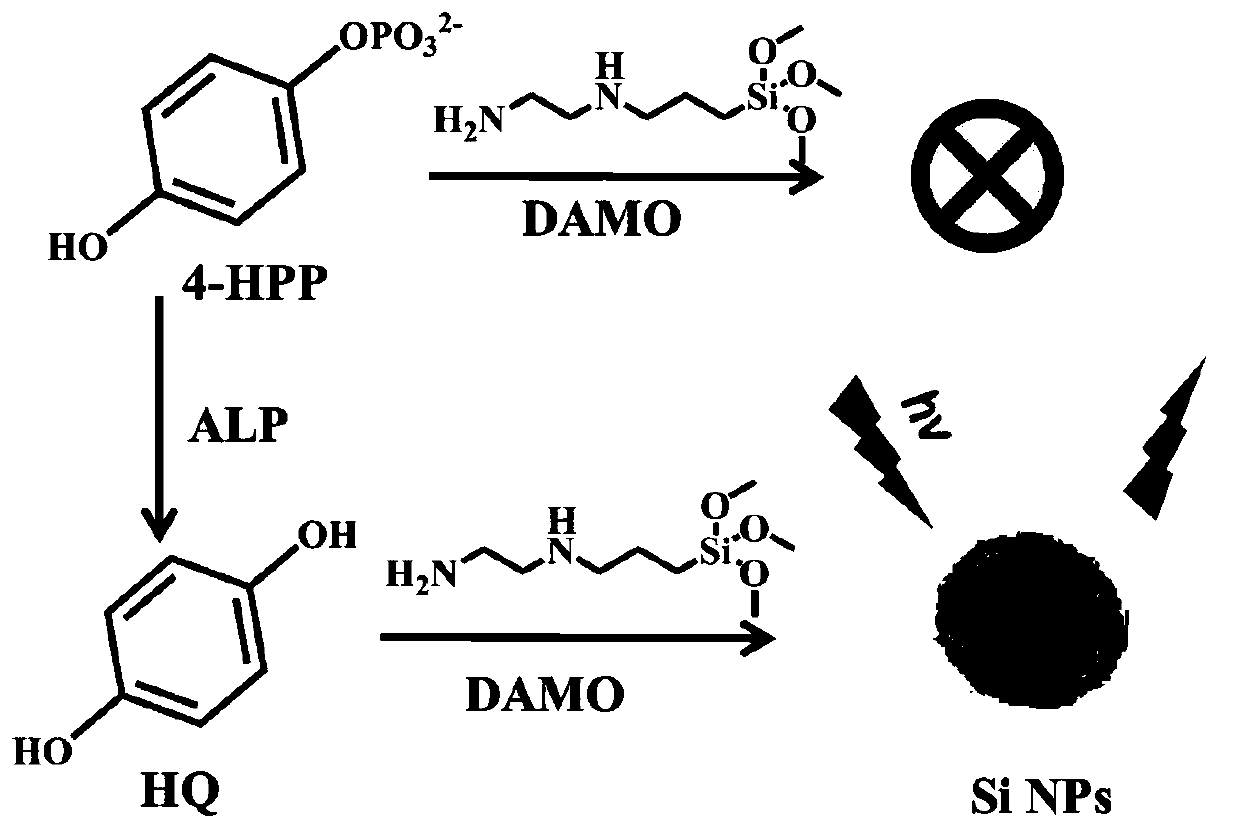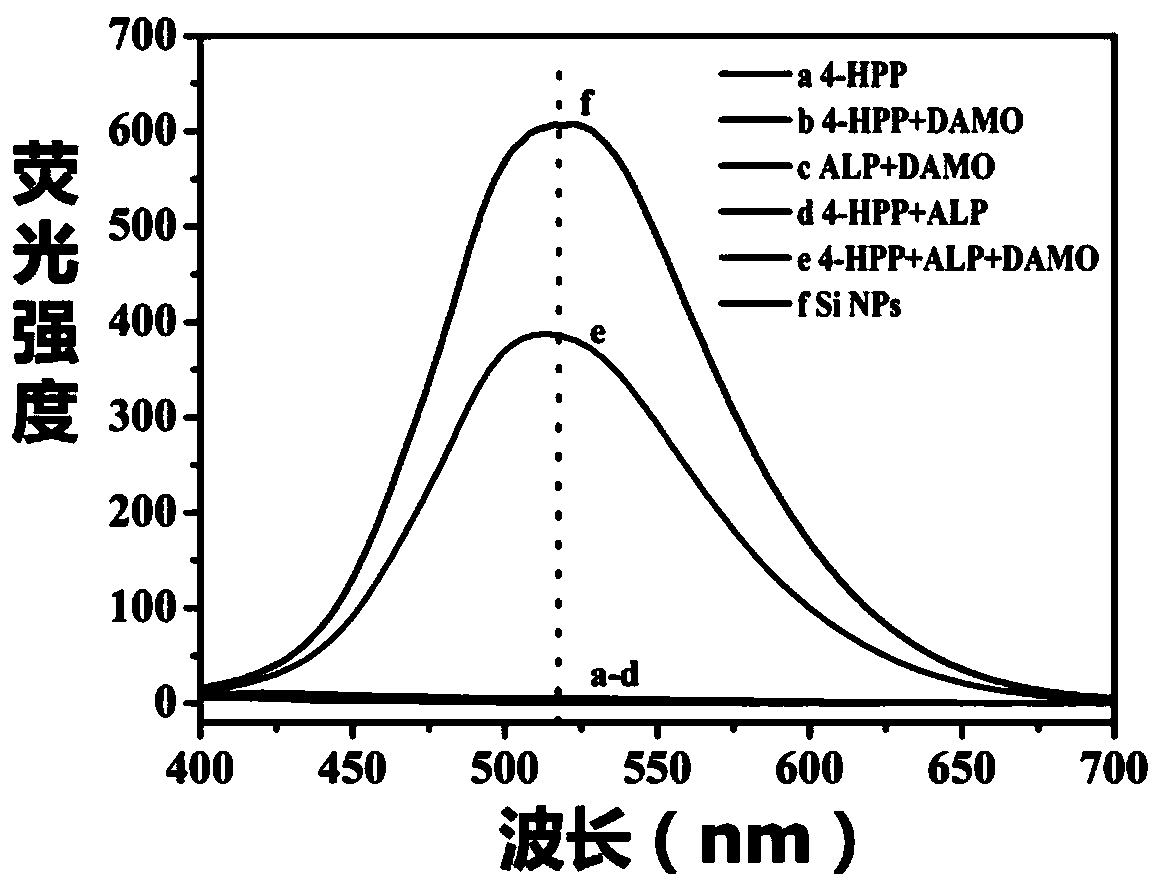Fluorescence detection method for activity of alkaline phosphatase
A technology for phosphatase activity and fluorescence detection, applied in the field of analysis and detection, can solve the problems of large isotope labels, complicated operation, time-consuming and inefficient, etc., and achieve the effect of high selectivity, high sensitivity, and simple medicine
- Summary
- Abstract
- Description
- Claims
- Application Information
AI Technical Summary
Problems solved by technology
Method used
Image
Examples
Embodiment 1
[0033] Principle and feasibility verification of the inventive method
[0034] attached figure 1 It is a schematic diagram of the principle of the fluorescence detection method for alkaline phosphatase activity of the present invention. First verify the feasibility of the present invention, as figure 2 As shown, the mixed solution of 1,4-benzenediol HQ and DAMO was incubated at 37°C for 60 minutes, and the fluorescence of the system was measured with a fluorescence spectrophotometer, excited at 370nm, and there was obvious fluorescence emission at 520nm (f); while 4 -HPP aqueous solution (a) has no fluorescence emission near 520nm; DAMO (b) or alkaline phosphatase (d) is added alone to 4-HPP solution, and incubated at 37°C for 60 minutes, there is no obvious fluorescence; DAMO and alkaline phosphoric acid The enzyme mixed solution (c) also has no fluorescence after incubation; only when 4-HPP and alkaline phosphatase are incubated together, then adding DAMO for incubation c...
Embodiment 2
[0036] Synthesis and Characterization of Fluorescent Silicon Nanoparticles
[0037] Dissolve 100mg of HQ into 95mL of ultrapure water, add 5mL of DAMO, mix well and incubate at room temperature (~25°C) for 80min. The supernatant was lyophilized and dissolved in ultrapure water and placed in a refrigerator at 4°C for use. Such as image 3 As shown, the synthesized silicon nanoparticles have obvious absorption spectra different from those of the two initial reactants HQ and DAMO, and have obvious fluorescence. The maximum fluorescence excitation peak and emission peak are located near 370nm and 520nm, respectively. Transmission electron microscope showed that the morphology of silicon nanoparticles was spherical with an average particle diameter of about 70 nanometers. In addition, the test results of infrared spectroscopy and X-ray photoelectron spectroscopy also confirmed the existence of fluorescent silicon nanoparticles.
Embodiment 3
[0039] A kind of fluorescent detection method of alkaline phosphatase activity
[0040] First, 225 μL of 2.0 mM 4-HPP and 405 μL of ultrapure water were added to 180 μL of Tris-HCl (50 mM, pH 8.5, containing 50 μM MgCl 2) buffer solution, and then mixed the prepared 4-HPP mixed solution with 90 μL of different active alkaline phosphatase standard solutions (0, 0.1mU / mL, 0.2mU / mL, 0.3mU / mL, 0.5mU / mL, 0.7mU / mL, 0.9mU / mL, 1mU / mL, 2mU / mL, 3mU / mL, 5mU / mL, 10mU / mL, 15mU / mL, 20mU / mL, 30mU / mL, 40mU / mL, 50mU / mL) , and the alkaline phosphatase solution to be tested were incubated at 37°C for 60 minutes, and then 100 μL of DAMO (50% aqueous solution) was added, and the resulting mixed solution was incubated for 80 minutes at room temperature (~25°C), and then analyzed by fluorescence spectrometry. A luminometer measures the fluorescence of the solution. Such as Figure 4 As shown, the fluorescence emission spectrum intensity of the obtained solution increases with the enhancement of a...
PUM
 Login to View More
Login to View More Abstract
Description
Claims
Application Information
 Login to View More
Login to View More - R&D
- Intellectual Property
- Life Sciences
- Materials
- Tech Scout
- Unparalleled Data Quality
- Higher Quality Content
- 60% Fewer Hallucinations
Browse by: Latest US Patents, China's latest patents, Technical Efficacy Thesaurus, Application Domain, Technology Topic, Popular Technical Reports.
© 2025 PatSnap. All rights reserved.Legal|Privacy policy|Modern Slavery Act Transparency Statement|Sitemap|About US| Contact US: help@patsnap.com



